| An investigation of the annual celebrations and rituals of Los Dias de los Muertos, the annual fiesta of the Days of the Dead in Mexico, offers an opportunity for understanding the meaning of this important cultural tradition. November 1, All Saints' Day, and November 2, All Souls' Day, are the most important holidays of the year in Mexico, especially in rural areas. It is a joyful time of remembrance, reunion, and feasting, as families gather together to honor their loved ones who have died. Los Dias de los Muertos is not somber, morbid, or macabre.
|
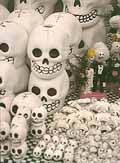
|
In the United States, misconceptions sometimes arise about Los Dias de los Muertos because of differing cultural attitudes about death, misinterpretation of the meaning of symbolic objects such as altars, skeletons, and skulls, and the concurrent dates of the celebration with Halloween.
|
Historical and Cultural Background
The origins of Los Dias de los Muertos in Mexico date back long before the arrival of the Conquistadors in the 1500s. Concepts of death and afterlife existed in the Olmec, Toltec, Maya, and Aztec cultures.
|
When the conquering Europeans introduced Christianity to the native cultures, its rituals and practices became synthesized with traditional indigenous beliefs. All Saints' Day and All Souls' Day are holy days celebrated in all Catholic countries, and the customs and practices of Los Dias de los Muertos developed from this fusion.
|
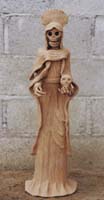
|
In Mexican culture there is a philosophical acceptance of death as an integral part of the cycle of life. During Los Dias de los Muertos, people believe that the souls of the dead return to earth for one day of the year - the spirits of los angelitos (children) on All Saint's Day and the spirits of adults on All Soul's Day.
Preparations
No expense is spared in preparing for Los Dias de los Muertos. Families participate in the construction and decoration of ofrendas (home altars) to honor loved ones. Decorations may include candles, gifts, flowers, papel picado (cut paper banners), pictures of saints, and photographs and offerings of the favorite food and drink of the deceased. Tombs and gravestones in the cemeteries are cleaned and freshly-painted.
Pan de los Muertos (Bread of the Dead), candies, and toys are made in the shapes of calavera (skulls and skeletons). The skeleton or skull is seen as a promise of resurrection, not as a symbol of death. Calavera toys and papier-mache figures wear modern dress. Popular skeleton figures depict specific profession, musicians, brides and grooms, bicycle riders, and other subjects from everyday life. There are rich traditions of folk art that incorporate calveras in many ways. For example, the Linares family of Mexico City is well-known for their fantastic papier- mache calaveras figures.
|
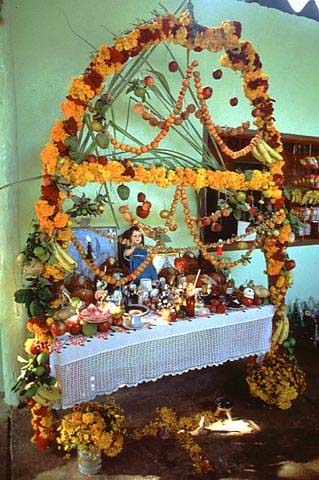
|
The traditional flower of Los Dias de los Muertos is the yellow marigold, which is spread on paths and used to decorate ofrendas and the cemetery. Its pungent scent is thought to help the spirits of the dead find their way home. Aromas are what attract and guide the spirits of the dead, so the pleasant odors of foods, copal incense, and marigolds help guide souls home and provide offerings.
|
Traditional Practices
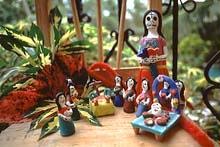
|
Los Dias de los Muertos begins on the night of October 31, La Noche de Duelo (The Night of Mourning) with a candlelight procession to the cemetery. The spirits of children arrive to visit their families on October 31 and depart on November 1, All Saints' Day. The souls of the adults then arrive, leaving on November 2, All Souls' Day.
|
The spirits of children are greeted at home; the adults are welcomed at home or at the cemetery. Families usually honor the adult who died most recently.
On the last evening of Los Dias de los Muertos, families often spend the night at the cemetery, praying, talking, and feasting. Sometimes music is played; sometimes a Catholic Mass is celebrated, but all the participants return home at sunrise.
|
Through the traditions of Los Dias de los Muertos, the celebrants honor and show respect for their deceased loved ones. They know that they, too, will not be forgotten after death as long as these traditions are maintained.
North Texas Institute for Educators on the Visual Arts
|
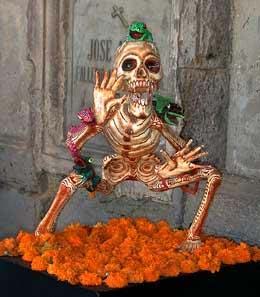
|
|